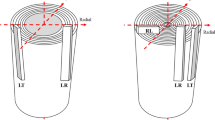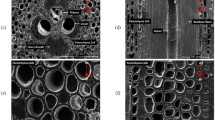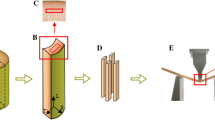Abstract
Bamboo is a naturally occurring composite material evolved with soft parenchymatous matrix reinforced by unidirectional fibre bundles. Moreover, it is functionally graded with fibre density varying smoothly over the transverse cross-section and it is characterised by structural hierarchy existing at various length scales. Therefore, mechanical characterisation of the material needs to be carried out using multi-scale modelling. In this paper, mechanical characterization of bamboo is discussed using state-of-the-art hybrid numerical-experimental technique. The techniques followed here are very modern and use the most recent methods. To achieve this, three length scales are identified and specimens are prepared accordingly. The specimens correspond to namely, nano-indentation, brittle failure of fibre bundle and inter-laminar fracture in bulk bamboo. Effective elastic moduli of bulk bamboo obtained through homogenisation are used for numerical analyses. An analytical framework for nano-indentation of anisotropic substrate is presented and results are compared with experimental results. The indentation modulus is observed to lie between 19 and 21 GPa whereas, the results obtained experimentally lie between 17 and 23 GPa. Further, finite element analysis of nano-indentation of anisotropic surface of bamboo is also discussed, where indentation modulus is found to be 20.2 GPa. While discussing brittle failure of fibre bundle, statistical weak-link theory based on progressive failure is presented and comparison is made between statistical and experimental results. In the last part, fracture of bulk specimen is studied using asymptotic crack-tip stress field in anisotropic material that is used for estimation of energy release rate. The fracture energy is seen to vary between 500 and 1800 N/m. The results are compared with fracture experiments conducted on inter-laminar bamboo specimens. It is concluded that mechanical properties of a hierarchical material can be estimated through multi-scale modelling and experiments on specimens selected suitably at different length scales.





Similar content being viewed by others
References
M. Sayyad, J.P. Knox, S. Basu, Correlations between axial stiffness and microstructure of a species of bamboo. Royal Soc. Open Sci. 4(1), 160412 (2017)
M. Sayyad, M. Zaffar, A. Pradhan, S. Basu, Measurement of microfibril angles in bamboo using mueller matrix imaging. Appl. Opt. 55(32), 8971–8978 (2016)
U.G.K. Wegst, M.F. Ashby, The mechanical efficiency of natural materials. Phil. Mag. 84(21), 2167–2186 (2004)
H. Li, S. Shen, The mechanical properties of bamboo and vascular bundles. J. Mater. Res. 26(21), 2749–2756 (2011)
J. Fish, G.J. Wagner, S. Keten, Mesoscopic and multiscale modelling in materials. Nat. Mater. 20(6), 774–786 (2021)
J. Cui, Z. Qin, A. Masic, M.J. Buehler, Multiscale structural insights of load bearing bamboo: A computational modeling approach. J. Mech. Behav. Biomed. Mater. 107, 103743 (2020)
F. Greco, L. Leonetti, A. Pranno, S. Rudykh, Mechanical behavior of bio-inspired nacre-like composites: A hybrid multiscale modeling approach. Comp. Struct. 233, 111625 (2019)
T. Gangwar, D. Schillinger, Microimaging-informed continuum micromechanics accurately predicts macroscopic stiffness and strength properties of hierarchical plant culm materials. Mech. Mater. 130, 39–57 (2019)
T. Gangwar, D.J. Heuschele, G. Annor, A. Fok, K.P. Smith, D. Schillinger, Multiscale characterization and micromechanical modeling of crop stem materials. Biomech. Model. Mechanobiol. 20(1), 69–91 (2021)
U.G.K. Wegst, H. Bai, E. Saiz, R.O. Ritchie, Bioinspired structural materials. Nat. Mater. 14(1), 23–36 (2014)
ASTM D5528, Standard test method for mode I interlaminar fracture toughness of unidirectional fiber-reinforced polymer matrix composites (2013)
M.F. Doerner, W.D. Nix, A Method for Interpreting the Data from Depth-sensing Indentation Instruments. J. Mater. Res. 1, 601–609 (1986)
W.C. Oliver, G.M. Pharr, An improved technique for determining hardness and elastic modulus using load and displacement sensing indentation experiments. J. Mater. Res. 7, 1564–1583 (1992)
J.J. Vlassak, W. Nix, Measuring the elastic properties of anisotropic materials by means of indentation experiments. J. Mech. Phys. Solids 42(8), 1223–1245 (1994)
J. Vlassak, A model for chemical-mechanical polishing of a material surface based on contact mechanics. J. Mech. Phys. Solids 52(4), 847–873 (2004)
D. Barnett, J. Lothe, Line force loadings on anisotropic half-spaces and wedges. Physica Norvegica 8, 13–22 (1975)
S. Swaddiwudhipong, J. Hua, K.K. Tho, Z.S. Liu, Equivalency of berkovich and conical load-indentation curves. Modell. Simul. Mater. Sci. Eng. 14(1), 71–82 (2006)
M. Sayyad, V. Parameswaran, S. Basu, Stiffness and toughness gradation of bamboo from a damage tolerance perspective. Int. J. Solids Struct. 143, 274–286 (2018)
F. Desrumaux, F. Meraghni, M. Benzeggagh, Micromechanical modelling coupled to a reliability approach for damage evolution prediction in composite materials. Appl. Compos. Mater. 7(4), 231–250 (2000)
J. Biagiotti, S. Fiori, L. Torre, M. López-Manchado, J.M. Kenny, Mechanical properties of polypropylene matrix composites reinforced with natural fibers: a statistical approach. Polym. Compos. 25(1), 26–36 (2004)
W. Weibull et al., A statistical distribution function of wide applicability. J. Appl. Mech. 18(3), 293–297 (1951)
J. Andersons, E. Spārniņš, R. Joffe, L. Wallström, Strength distribution of elementary flax fibres. Compos. Sci. Technol. 65(3–4), 693–702 (2005)
C. Truesdell, R. Toupin, The Classical Field Theories (Springer, Berlin, Heidelberg, 1960), pp.226–858
G.C. Sih, P.C. Paris, G.R. Irwin, On cracks in rectilinearly anisotropic bodies. Int. J. Fract. Mech. 1(3), 189–203 (1965)
M.H. Sadd, Elasticity: Theory, Applications, and Numerics (Elsevier Science, 2009)
Acknowledgements
The authors would like to thank the botanical nursery for providing bamboo shoot and the High-Speed Experimental Mechanics Laboratory at IIT Kanpur, India.
Funding
This research did not receive any specific grant from funding agencies in the public, commercial, or not-for-profit sectors.
Author information
Authors and Affiliations
Corresponding author
Ethics declarations
Conflict of interest
The author declare that have no conflict of interest.
Additional information
Publisher's Note
Springer Nature remains neutral with regard to jurisdictional claims in published maps and institutional affiliations.
Appendices
Appendix A. Progressive Failure Model for Bulk Bamboo

Appendix B. Inter-laminar Cracks in Anisotropic Material
For an anisotropic material as shown in Fig. 6, generalised Hooke’s law is expressed as:
where,
The compliances \(\mathbbm {S}_{{ij}}\) are defined in Sadd [25]. Sih et al. [24] have formulated the stress and displacement are formulated in terms of analytic functions \(\phi _{j}(z_j)\), of the complex variable, \(z_{j}=x_{j}+iy_{j}\) (\({j}=1, 2\)), where
The complex numbers \(\mu _{j}\) are formed from the parameters \(\alpha _{j}\;\mathrm {and}\;\beta _{j}\) (\({i.e.,}\;\mu _{j}=\alpha _{j}+i\beta _{j}\)) which are determined from
The roots, \(\mu _{j}\) turn out to be always complex and will form conjugate pairs. In this work, the roots with positive imaginary parts are used. In addition, the stress-intensity factors \(K_{j}\) (\(j=1, 2, 3)\)are related to the energy release rates, \(G_{j}\). For inter-laminar fracture (mode−I), it is found that [24]:
Appendix C. Compliance Calibration (ASTM D5528)
-
1.
Plot log \((\delta _{{i}}/P_{i})\) versus log \(a_{i}\).
-
2.
Draw a least squares straight line fit through the data.
-
3.
Determine the slope of straight line, \(n=\Delta _{{y}}/\Delta _{x}\).
-
4.
Find out mode−I inter-laminar fracture toughness as \(G_{\mathrm {I}}=\dfrac{nP\delta }{2ba}\), where C is compliance (\(C=\delta /P\)) of specimen.
Rights and permissions
Springer Nature or its licensor holds exclusive rights to this article under a publishing agreement with the author(s) or other rightsholder(s); author self-archiving of the accepted manuscript version of this article is solely governed by the terms of such publishing agreement and applicable law.
About this article
Cite this article
Sayyad, M. Investigations into Multi-scale Mechanical Characterization of Bamboo- a Natural Material. J. Inst. Eng. India Ser. C 103, 1389–1397 (2022). https://doi.org/10.1007/s40032-022-00884-y
Received:
Accepted:
Published:
Issue Date:
DOI: https://doi.org/10.1007/s40032-022-00884-y





